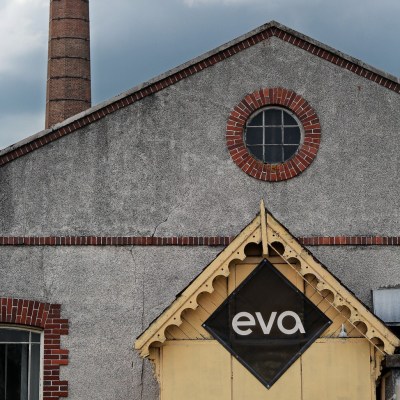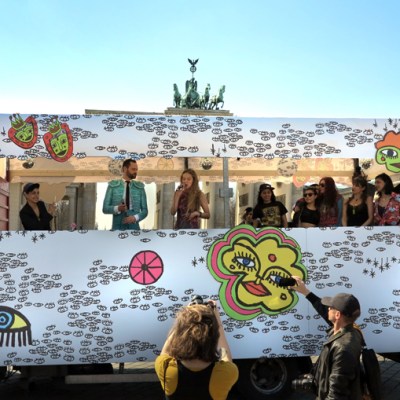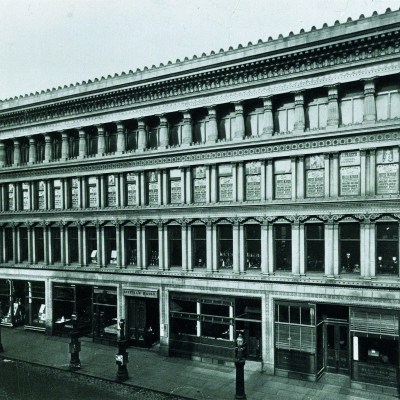Tam Shepherd’s Trick Shop has stood on Glasgow’s Queen Street for over a century, filling generations of children’s party-bags with whoopie cushions, catapults and false moustaches. It’s been around long enough to become an institution: a mark by which the city knows itself. Tam’s is perhaps the last place in Glasgow you’d expect to find a contemporary art installation. But at this year’s Glasgow International, artworks lie concealed among the tricks.
Beside a spring-loaded jar of Coleman’s mustard sits a baguette endowed with a pair of goggly eyes (Jack Cheetham’s ‘Bred II’). In the mouth of a toy whale, dangling from a piece of string attached to the ceiling, are two tiny figurines of artists Beagles and Ramsay. It’s as though a miniature Gilbert and George have assumed the role of Jonah. At the till, I’m told that I won’t be able to see an exhibit called Total Crap, by David Sherry. They’ve sold out. Instead, I’m shown a picture of these small white boxes, the labels of which satirise modern art while conjuring a sense of the substance they may or may not contain. They’ve been outselling Tam’s own plastic dog dung, the manager remarks.
Installation view of Kidney Punch Update (2018) by Beagles and Ramsay (top shelf, centre) in the ‘Good £uck’ exhibition at Tam Shepherd’s Trick Shop, part of Glasgow International 2018. Courtesy the artists

The eighth edition of Scotland’s largest biennial is its largest to date, with 90 exhibitions spread across 78 venues in all quarters of the city. It includes new commissions by Turner Prize-winners Lubaina Himid and Mark Leckey, and an ambitious new façade by Mick Peters for an old gas purifier shed in Dalmarnock, which is covered in cartoons satirising the idea of gentrification in Glasgow’s East End. The central programme, curated by the event’s director Richard Parry, asks if we have been rendered mere ‘administrators of our own psyche’ by the internet, ‘complicit in the deal we do with companies to share information about ourselves’; it poises the present moment midway between utopia and dystopia.
Dark Continent: SEMIRAMIS by Tai Shani at Tramway, Glasgow International 2018. Photo: Keith Hunter

‘Dark Continents’, Tai Shani’s powerful, episodic performance-piece at Tramway, creates, through ruminative choreography and Joycean monologue, a fantastical erotic resolution to the psychic violence women have been subjected to for millennia. Hardeep Pandhal’s installation at the Kelvin Hall, on the other hand, seems viciously self-questioning. His series of cut-out caricatures – stereotypical trappings of British life, from a pencil-thin sergeant major to an anthropomorphised Doc Marten each scrawled over with rap lyrics testifying to the experience of second-generation Sikh life – are on one level a colossal send-up of the authority vested in British traditions. However, accompanied by a series of film fragments that lampoon the factionalism that plagued a month-long sit-in protest at Leeds University in 2011, the figures are also a tacit acknowledgement of their own futility. ‘Art is not enough,’ you’re told in the exhibition’s climactic moments. The anarchic wit of Pandhal’s figures is knowingly, powerfully lame.
Still, the Good £uck exhibition at Tam Shepherd’s seems to me the best first port of call. For what’s most memorable about this festival is the inventiveness with which so many of the artists have used the fabric of the city itself as their medium, creating an intimate, absurd, and frequently alarming dialogue between art and civic space.
Installation view of Head (2018) by Nicolas Party at The Modern Institute, part of Glasgow International 2018. Photo: Patrick Jameson; courtesy the artist and The Modern Institute/Toby Webster Ltd, Glasgow

Down the road from Tam’s, at the British Heart Foundation, an exhibition of paintings has been propped on second-hand sofas. While I stand before a picture of an astonished badger clapping human hands to its snout, a store attendant clips the frayed threads of the couch on which it sits. Meanwhile, outside The Modern Institute, Nicolas Party’s giant purple head looks out on the cars parked behind the St Enoch’s shopping centre. The festival intrudes on Glasgow, on its history and its daily life, like a series of experiential glitches.
Through the rooms and corridors of The Common Guild – a spacious Victorian townhouse on Woodland’s Terrace, overlooking Kelvingrove Park – Katinka Bock’s lead pipework snakes its aimless way. Dead lead fish are strewn across the stairs, inviting you to imagine something invisible, something noxious seeping into the property. In a half-refurbished office block on Renfrew Street, a disused room is the setting for an exhibition of dilapidated classical plaster casts. Before you’ve followed the festival around for long, you start thinking of its relation to its host city as a kind of psychic infestation, a fever that’s touched the mind of the place.
Installation view of ‘Radio Piombino’ by Katinka Bock at The Common Guild, part of Glasgow International 2018. Photo: Ruth Clark; courtesy the artist

But it’s precisely from this feeling – this growing sense of the built environment as a warped organism – that the more ambitious questions posed by the festival draw their urgency. Only after the readymade absurdity of Tam Shepherd’s, for instance, does the giant digital screen-print that greets you in the Gallery of Modern Art make sense. The neoclassical gallery seems to continue unhindered by the print, in which the room’s Corinthian columns are repeated to create a careful calibrated effect of spatial recession. It would be trompe l’oeil, were it not for the fact that the artist, John Russell, has photoshopped a massive elephant in the way of your view. As the screen-print distorts your sense of the space, the festival’s process of estranging you from ‘Glasgow Institutions’,whether Tam’s or GoMA, becomes more pronounced. It’s hard to keep a sense of where you stand.
Glasgow International 2018 is at various venues in Glasgow until 7 May.



